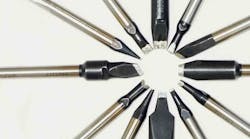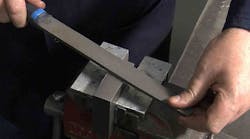Soldering is a joining process involving a filler metal that is used to fuse two adjoining materials: the filler metal is chosen for having a lower melting point than either of the two materials, and a heat source is used to bring the filler metal to a temperature that will ensure it adheres to those materials.
A soldering iron is an invaluable tool in various manufacturing settings, but that iron only as good as its tips. If they're not maintained correctly, they can easily become useless in no time. If you use a soldering iron on a regular basis and find you have to replace the tips more often than you would like, here are some tips and tricks to make caring for them easier.
Keep Your Supplies on Hand — There are a couple of things you'll need to keep on hand to maintain your soldering iron. Thankfully, they're easy to get your hands on and you might even have a couple of them in your garage already. Make sure you have:
• A damp yellow sponge: Make sure you keep a damp (not soaked) sponge around. Avoid sponges made from synthetic materials if at all possible because they can melt and get stuck to your iron.
• 600-grit sandpaper: You won't always need sandpaper, but it's good to have on hand anyway.
• Extra solder or a tip tinner: We'll go more into this in a minute.
Assess the Damage — If you share a soldering iron with other team members, it might take a bit more work to get it back in fighting shape, so to speak. Is the tip dull and brown, or does it appear oxidized or rusted? This is where you might need the sandpaper. Wait until the iron is cool, and sand the tip until you start to see some shine again. You don't want to remove the metal of the tip — just the oxidation layer that prevents it from heating properly.
Pick the Right Tool for the Job — Not all soldering irons are created equal, and it's important to pick the right one for the job. A professional WE1010 soldering iron, which is 40% more powerful than the WES/WESD station, can be a great choice for beginners and even some professional applications. However, it wouldn't work well for micro-components and jewelry. Make sure you pick a soldering iron that works well for your particular job. You don't need the highest heat setting, for example, if you're working on metals that might melt right along with the solder.
Cleaning a Hot Iron — This is where your sponge will come in. If your iron is hot but the tip is dull or dirty, let it sit for a minute or two to regain its heat, then flick it against your damp sponge. This will allow you to clean off any residue and leave the tip ready for another use — after the next step, that is. Make sure you don't hold the sponge in your hand when you're doing this, because water transmits heat really well.
Tinning the Tip — Once you've got a clean soldering iron tip, there's one more thing to do before you can pack your soldering iron away to use another day, and that's tinning the tip. The goal here is to coat the tip of the iron with a thin layer of solder. This can be done in one of two ways.
• Use a tinning compound, if you have it; you can pick it up at a local hardware store. Pressing the hot tip into the tinning compound will allow you to coat the tip.
• If you don't have a tinning compound, low-temperature solder is good for this; it cools quickly and keeps you from frying the solder to the tip.
Most of these steps can be done right after you're done with your soldering job and they don't take a lot of time. By properly maintaining your soldering iron's tip, you will be able to use it for years to come. A properly maintained soldering iron won't need a lot of work, and you can even bring a badly abused tip back from the brink with a little bit of elbow grease. Don't worry too much about a totally trashed tip though. If it's beyond restoration, it's easy to replace the whole tip so your soldering iron will be as good as new.
Megan Nichols is an amateur astronomer and environmentalist, and writes on a wide range of scientific topics. Her recent contributions to AmericanMachinist.com, have included Tips for Implementing CNC Machine Preventive Maintenance and What Does ISO 9001:2015 Mean for Machine Shops?, and many others. Follow Megan on Twitter @nicholsrmegan.








